The most recent statement from the C.E.O of Alaska Airlines has once again raised concerns about the safety of the aviation industry. The airline’s chief executive divulged that in light of an almost catastrophic occurrence involving their Max 9 planes, a plethora of loose bolts were discovered in the aircrafts. This shocking revelation not only exposes the breadth of structural issues regarding the Max 9 planes but also begets several questions about their quality control and inspection processes.
The Max 9 airplanes, designed by the Seattle-based manufacturing giant Boeing, have sent shock waves throughout various stakeholders of the global airline industry. The latest bolt issue, as reported by Alaska Airlines, has undeniably heightened concerns around the functionality and rigidness of the Max 9 planes.
It should be mentioned that the process of discovering loose bolts on the plane was not incidental. Rather, it came as a result of a step-by-step procedural investigation that was triggered following the nearly disastrous situation involving the airline. Had the close call not occurred, this glaring anomaly could have stayed undetected, consequently leading to potentially tragic consequences.
Several experts in the aviation industry are concerned as to how the quality assurance checks missed the loose bolt issue. The aviation industry is known to have one of the most rigorous and robust assessment protocols. Yet, the current scenario alludes to a possiblity of an inadequate inspection process, or even a systemic failure which would require a significant overhaul.
The proliferation of loose bolts not only poses a threat to air safety but it also critically affects the airlines’ reputation, financially and operationally. The costly repairs required to solve such mechanical problems affect the profitability of an airline. Moreover, flight cancellations or delays due to mechanical lapses are often compensated by the carriers, adding to their expenditure.
Overall, the responsibility of maintaining a company’s fleet in perfect operating order is shared among manufacturers, airline maintenance operations and inspectors. The revelation by Alaska Airlines CEO about the loose bolts in their Max 9 fleet effectively places the onus on all these stakeholders to recognize and rectify such critical faults efficiently and expeditiously.
Currently, Alaska Airlines, as well as the aircraft manufacturer, Boeing, has been subjected to intense scrutiny about their quality checks and control systems. This incident significantly impacts the trust placed in both these entities not only by stakeholders such as investors and employees but also by the general public who use their services.
These alarming revelations have led to widespread demands for better safety checks and a more rigorous overview of maintenance procedures by airlines and manufacturers worldwide. This incident serves as a potent reminder that all aspects of airline operations, including the regular maintenance and inspection protocols, need to undergo rigorous checks and scrutiny to ensure that air travel remains one of the safest modes of transport.
Today, the aviation industry is more in the public eye than ever before and the numerous reports of safety lapses only increase calls for enhanced transparency and accountability. While airplane manufacturers must ensure the integrity of the aircraft design, airlines and maintenance personnel must ensure all safety checks are done under the highest standards. With the shared objective of prioritizing safety over everything else, the aviation industry’s most significant task is to reestablish public fidelity and ensure aircraft credibility.
In the end, the discovery of these loose bolts in the Max 9 planes by Alaska Airlines is indeed alarming. It acts as a wake-up call for the wider industry to redefine the quality and safety protocols to prevent further such instances. Through more stringent measures and improved collaborative efforts among all stakeholders, we can hope for an aviation industry that lives up to its reputation as a secure and reliable mode of transportation.




